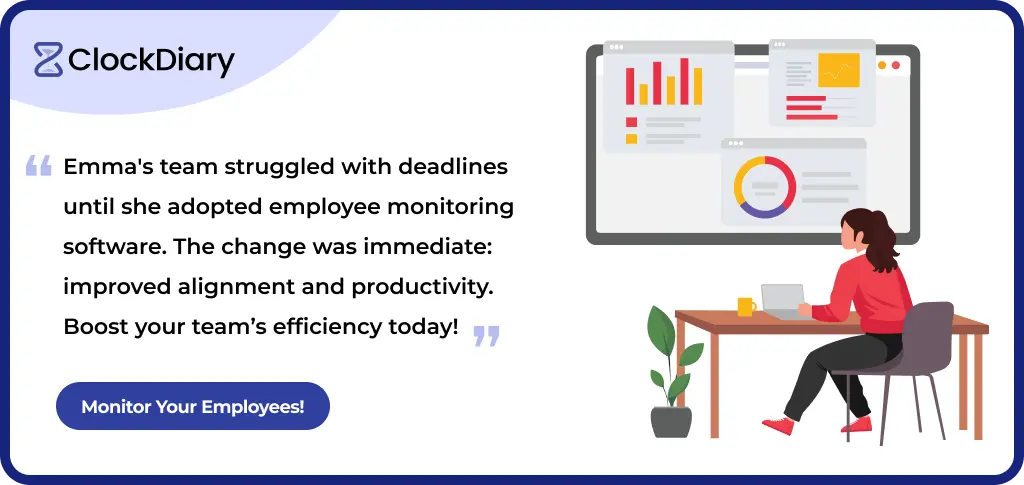Employee monitoring is a vital practice for businesses aiming to enhance productivity while respecting employee privacy. Modern monitoring focuses on transparency, ethical use, and building trust within the workforce.
| Quick Summary: This blog explains employee monitoring, including its definition, types, benefits, and drawbacks. It discusses legal requirements and best practices for ethical implementation. It also highlights current trends and features Clockdiary’s tools designed to improve productivity while protecting privacy. |
This blog covers what employee monitoring is, its types, pros and cons for both employers and employees, and essential legal considerations. You’ll also find practical advice on how to implement monitoring effectively and stay updated on the latest industry trends. Plus, discover how Clockdiary’s employee monitoring tools can help you manage your team efficiently and ethically.
What is Employee Monitoring?
Employee monitoring, also known as employee tracking, typically refers to tracking and monitoring staff members’ activities and performance during work hours to ensure productivity and compliance with company policies.
There are several channels that you can take to undertake such monitoring, including software that tracks internet activity, computer usage, email correspondence, and even remote workers’ live locations.
The primary aim of employee monitoring is to improve productivity by providing employers with valuable insights into how time is spent and figuring out areas where efficiency can be improved.
Also, by monitoring employees, you can safeguard sensitive information, maintain operational standards, and ensure adherence to company policies.
Speaking about the systems available for monitoring, they range from tracking tools to comprehensive solutions that take screenshots, record keystrokes, and analyze behavioral patterns.
In the next section, we will discuss the pros and cons of employee monitoring, both from the viewpoint of employers and employees.
Pros of Employee Monitoring
When implemented with proper planning, employee monitoring can be a boon for both the employer and employees in more ways than one.
Let’s take a look at how implementing this can improve daily business operations.
For Employers
- Increased Productivity: Monitoring helps identify distractions and inefficiencies, allowing employers to address potential roadblocks and enhance productivity.
- Improved Security: Tools available for employee monitoring detect unusual behavior and avert data breaches. These supremely engineered tools safeguard sensitive information while promoting accountability as well.
- Enhanced Performance Evaluation: Accurate tracking of work activities provides objective data for performance assessments, making evaluating employee performance and contributions as easy as it can get.
- Better Resource Allocation: Monitoring helps analyze resource utilization. This, in turn, helps directors optimize allocation and point out areas that call for additional support.
- Compliance and Legal Protection: Monitoring ensures that your company adheres to pre-determined policies and regulatory requirements, thereby maintaining operational standards and mitigating the risk of legal issues.
For Employees:
- Clear Expectations: Monitoring sets clear expectations, helping team members understand their goals and responsibilities. This goes a long way in improving job clarity.
- Recognition and Rewards: With comprehensive performance data, workers would receive rewards and recognition for their achievements, promoting satisfaction and motivation.
- Work-Life Balance: Maintaining work-life balance is now a breeze with tools available for employee monitoring .These tools can recognize workload imbalances and prevent overwork, thereby fostering a healthier work-life balance and negating burnout risks.
- Skill Development: The insights gained from monitoring can put the spotlight on areas for improvement and training requirements, facilitating career growth and skill development.
Cons of Employee Monitoring
Although employee monitoring offers valuable insights into productivity, it also has some significant drawbacks for both employers and employees. But what are the negatives? Well, here they are.
For Employers
- High Implementation Cost: The initial setup and regular maintenance of tools available for employee monitoring, such as an employee tracker, can be expensive. This includes hardware upgrades, software costs, and potentially hiring IT staff to manage the system efficiently.
- Legal and Compliance Risk: Monitoring must adhere to various legal standards, which can vary from one jurisdiction to another. Failure to comply can lead to financial penalties and legal complexities.
- Employee Morale and Trust Issues: Excessive monitoring can affect trust between management and employees. Workers might feel that they are micromanaged, something that can hamper workplace relationships and overall morale.
- Impact on Company Culture: An omnipresent monitoring environment can create a culture of surveillance, thereby eroding open and collaborative communication. This can negatively affect an employee’s ability to gel with their colleagues, which, in turn, would affect the overall company culture.
For Employees
- Privacy Concerns: Employee monitoring can intrude into personal privacy, leading to dissatisfaction and discomfort among team members. They might feel their personal space is being invaded.
- Negative Impact on Morale: Continuous oversight can diminish motivation and job satisfaction. Workers might be under the impression that they are not valued or trusted.
- Communication Barriers: Employees might become less open and communicative, fearing that their every move is being monitored and judged. This can hinder bringing out innovative ideas and teamwork.
Now, that you have a fair idea of the various pros and cons of employee monitoring, let’s take a look at the different types prevalent all over the US.



